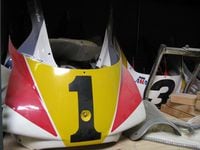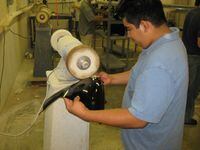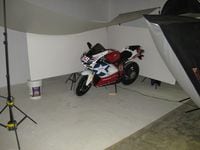Motorcyclist goes behind the scenes at Zero Gravity's Camarillo, CA facility. Motorcyclist recently received an invitation to tour Zero Gravity’s headquarters in Camarillo, California. Zero Gravity has been in the windscreen business for over 20 years, and in that time they’ve become the world’s largest and most respected windscreen brand. Professional racers like Mat Mladin, Ben Spies, Tommy Hayden, and the Bostrom brothers have all ridden and won using Zero Gravity screens.
[ Our tour started in the front offices, where a tricked-out Triumph Daytona 675 sits on display. Tearing our eyes away from the custom paint, polished wheels, and other custom bits wasn’t easy, but our tour guide, Sales Manager Sergio Garcia, insured us there would be other, equally interesting items further along.
To give us a view into the personality behind ZG, we were shown company owner Glenn Cook’s personal workshop and storage space. Aside from motorcycles and road racing, Glenn has a passion for classic Italian cars – Maserati’s in particular – as well as a love for music. An entire wing of the Zero Gravity facility is dedicated to Glenn’s musical passion, and houses his collection of pianos and harpsichords.
[ Unfortunately, due to the proprietary technology involved in Zero Gravity’s screen production, we weren’t allowed to photograph the most interesting parts of the tour. We did get to see the process pretty much from start to finish, and the manufacturing procedure is a lot more specialized, meticulous, and precise than we would have imagined.
Creating a perfect windscreen begins with basic plastic stock, which Zero Gravity has in abundance. Huge stacks of the stuff line the walls, extending up towards the ceiling. The excellent optical clarity of Zero Gravity’s screens it the result of a careful manufacturing process. Their proprietary blow-molding procedure starts with a 4 x 3 foot sheet of raw material. Thesheet isplacedinto a mold and pressurized to create the required shape. All this takes place under the watchful, well-trained eye of the blow-molding operator, who controls the air pressure to create another perfect screen.
Because of the shape and size of the molds, all screens are produced two at a time. From the blow-mold they are moved to the cutting room, where the two screens are separated and trimmed. Rather than mechanically cutting the screen, which can leave a rough, uneven edge, Zero Gravity uses a proprietary procedure thatmakes a uniform, accurate cut, insuring a perfect fit and finish. The cut screen is then moved to the finishing room, where the edges are hand “flamed” on polishing wheels, leaving them smoothly beveled.
[The Camarillo facility keeps the top 350 screen models in stock. All screens are made in house, and if you happen to order one of the few screens they don’t currently have, they will make it to order.
ZG’s dedicated design team has a tough job. Their task is to create the molds and proofs that will be used to produce Zero Gravity’s Stock Replacement, Double Bubble, Sport Touring, and Corsa screens. ZG’s close relationship with professional racers and aftermarket bodywork manufacturers insures they are always the first to get bodywork from which to work. The process starts by reproducing the stock screen, after which the tooling and procedures for the other screen models begins.



















/cloudfront-us-east-1.images.arcpublishing.com/octane/HXOUJXQWA5HBHGRO3EMJIGFMVI.jpg)

/cloudfront-us-east-1.images.arcpublishing.com/octane/3TIWWRV4JBBOLDVGRYECVVTA7Y.jpg)
/cloudfront-us-east-1.images.arcpublishing.com/octane/KIX5O23D5NAIBGFXBN3327DKZU.jpg)
/cloudfront-us-east-1.images.arcpublishing.com/octane/7GJYDUIPXRGMTMQKN6ONYOLBOU.jpg)
/cloudfront-us-east-1.images.arcpublishing.com/octane/MUQLOVLL2ZDGFH25ILABNBXKTI.jpg)
/cloudfront-us-east-1.images.arcpublishing.com/octane/TNOU5DNE2BC57MFPMGN2EIDXAM.jpg)
/cloudfront-us-east-1.images.arcpublishing.com/octane/GTCXACQGJ5HAPDTGWUQKDEH44E.jpg)
/cloudfront-us-east-1.images.arcpublishing.com/octane/S35YGSEMEZB4BLTDJTSZPF4GLA.jpg)
/cloudfront-us-east-1.images.arcpublishing.com/octane/5UOT6HPX2JFMRJAX6EH45AR4MQ.jpg)
/cloudfront-us-east-1.images.arcpublishing.com/octane/OKWOJWAKP5EP3OACCRRWPCIX2Q.jpg)
/cloudfront-us-east-1.images.arcpublishing.com/octane/2WF3SCE3NFBQXLDNJM7KMXA45E.jpg)
/cloudfront-us-east-1.images.arcpublishing.com/octane/G4MG6OUCJNBSHIS2MVVOTPX65E.jpg)
/cloudfront-us-east-1.images.arcpublishing.com/octane/IIGGWFOTOJGB7DB6DGBXCCMTDY.jpg)
/cloudfront-us-east-1.images.arcpublishing.com/octane/QSTCM6AVEZA5JJBUXNIQ3DSOF4.jpg)
/cloudfront-us-east-1.images.arcpublishing.com/octane/U4I7G625B5DMLF2DVIJDFZVV6M.jpg)
/cloudfront-us-east-1.images.arcpublishing.com/octane/B6XD6LS6IVCQPIU6HXDJSM3FHY.jpg)
/cloudfront-us-east-1.images.arcpublishing.com/octane/ICL63FEDDRDTTMINYICCEYGMDA.jpg)
/cloudfront-us-east-1.images.arcpublishing.com/octane/FCGZHQXRBZFLBAPC5SDIQLVF4I.jpg)
/cloudfront-us-east-1.images.arcpublishing.com/octane/WNOB6LDOIFFHJKPSVIWDYUGOPM.jpg)

/cloudfront-us-east-1.images.arcpublishing.com/octane/X33NU3E525ECRHXLNUJN2FTRKI.jpg)
/cloudfront-us-east-1.images.arcpublishing.com/octane/6KKT5NNL2JAVBOXMZYS5ZO76YA.jpg)
/cloudfront-us-east-1.images.arcpublishing.com/octane/J5RKG5O455GMPGQRF2OG6LRT7A.jpg)